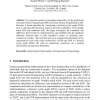Free Online Productivity Tools
i2Speak
i2Symbol
i2OCR
iTex2Img
iWeb2Print
iWeb2Shot
i2Type
iPdf2Split
iPdf2Merge
i2Bopomofo
i2Arabic
i2Style
i2Image
i2PDF
iLatex2Rtf
Sci2ools
EUROGP
2008
Springer
2008
Springer
A Comparison of Cartesian Genetic Programming and Linear Genetic Programming
Two prominent genetic programming approaches are the graph-based Cartesian Genetic Programming (CGP) and Linear Genetic Programming (LGP). Recently, a formal algorithm for constructing a directed acyclic graph (DAG) from a classical LGP instruction sequence has been established. Given graphbased LGP and traditional CGP, this paper investigates the similarities and differences between the two implementations, and establishes that the significant difference between them is each algorithm's means of restricting interconnectivity of nodes. The work then goes on to compare the performance of two representations each (with varied connectivity) of LGP and CGP to a directed cyclic graph (DCG) GP with no connectivity restrictions on a medical classification and regression benchmark.
Cartesian Genetic Programming | EUROGP 2008 | Genetic Programming | LGP Instruction Sequence | Optimization |
| Added | 19 Oct 2010 |
| Updated | 19 Oct 2010 |
| Type | Conference |
| Year | 2008 |
| Where | EUROGP |
| Authors | Garnett Carl Wilson, Wolfgang Banzhaf |
Comments (0)

